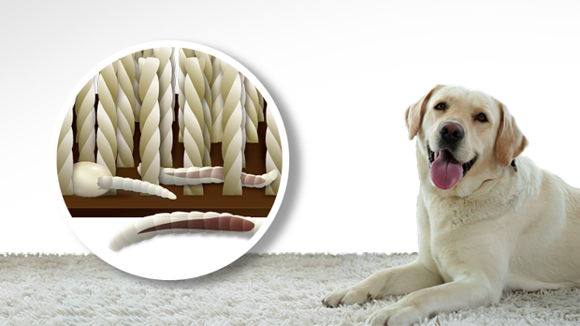
Img 1 Approximately 83% of fleas will be found developing in carpet fibers, concentrated in areas where pets rest. Only adult fleas live on pets.
Summary
Fleas do live in carpets. In fact, around 83% of fleas develop deep within carpeting. Only adult fleas live on their host and are parasitic. The eggs, larvae, and pupae all live within the environment (e.g. carpets).
Details
Adult Fleas Live on Animals
Adult cat fleas live on animals. Unless they’re dislodged through grooming, fleas become permanent residents of their acquired host.
Flea Eggs Develop in Carpets
Eggs are Laid on Hosts
Female fleas lay eggs directly on their host. The eggs are initially wet and sticky, but they dry quickly and become non-adherent. A majority fall from the host within two hours of being laid.
Eggs Fall into the Environment
Flea eggs continually fall into the environment. They’re dispersed wherever the infested animal wanders. However, most fall inside homes, amassing in areas where pets sleep, rest, and feed. Hot-spots often occur in living rooms and bedrooms. To survive, flea eggs must fall onto substrates with a warm, humid microclimate, such as carpeting. Viable zones for incubation aren’t widespread.
Flea Larvae Grow in Carpets
Carpet is an Ideal Larval Habitat
83% of fleas develop deep within home carpeting. Modern carpets have a deep pile that blocks out desiccating air flow and sunlight. It provides a harborage for larvae and keeps them hidden from view. They instinctively burrow to the base of the fibers. There, relative humidity and ambient temperature are kept constant. The canopy also protects larvae from insecticides and vacuum removal. To survive, larvae require plenty of food in the form of adult flea feces. The flea dirt easily gets trapped and accumulates in carpets.
Burrowing to Avoid Light & Traffic
Cat flea larvae live in dark environments. They’ll desiccate in open, sun-exposed areas due to high heat and low humidity. As a result, larvae burrow beneath the surface where light can’t penetrate. They’re rarely found carpeted areas that are exposed to excess sunlight. They also avoid hallways and other high-traffic areas.
Larvae don’t Move Far
Flea larvae don’t move far after hatching. Thus, they remain in areas where eggs fall. Like eggs, the larvae tend to be concentrated in carpeted rooms where pets often rest.
Cocoons are Spun in Carpeting
A mature larvae will move to an undisturbed location to spin a cocoon. The cocoon’s sticky silk collects debris from the environment, such as carpet fibers, and becomes camouflaged. During formation, cocoons get bound into the carpeting, making vacuum removal difficult.
Adults Emerge from Carpets
After pupating, adults remain within their cocoons until a suitable host is present. Pre-emerged fleas can remain in a quiescent state for months. After emerging, a flea will climb atop nearby objects, such as carpet fibers, where it’s able to jump onto a passing host. There, the flea orients itself towards sources of light. As a result, fleas tend to gather near openings where light enters, such as vents, crawl spaces, window sills, and other entrances.




You must log in to post a comment. Log in now.